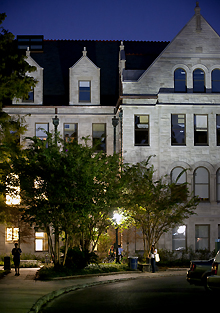Green Built, Gold Certified
Dinwiddie Hall, recently renovated on the Tulane uptown campus, has received Leadership in Energy and Environmental Design (LEED) Gold certification under standards set forth by the U.S. Green Building Council. The renovation of this historic building is the first construction project at Tulane to pursue and receive LEED certification.

Dinwiddie Hall, home to the Department of Anthropology and the Middle America Research Institute, is the first LEED-certified building on a university campus in Louisiana. (Photo by Paula Burch-Celentano)
The renovation project preserved the building's historic attributes while making strides in energy efficiency. Features from the original 1923 structure were reused wherever possible.
“Fifty-one percent of the existing building interior elements were reused, including doors and transoms, window frames and glass, plaster walls and hardwood flooring,” says campus planner Amber Mays Beezley. She also notes that 94 percent of the structural shell of Dinwiddie was reused, such as concrete floors, roof elements and exterior stone.
The project followed a process outlined by LEED to ensure greater energy efficiency. A computer model was constructed during the design phase to predict future energy use, and a building commissioner was hired to watch over the building's energy systems to ensure that they were properly designed and installed.
The project earned many LEED credits for actions protecting air quality inside the building, such as using low VOC (volatile organic compound) paints, sealants and adhesives. Conventional paints release VOCs into the air and often leave strong odors that can affect human health.
“These energy efficiency and air quality measures, as well as construction waste recycling, have now become a standard part of Tulane's new construction projects,” says Liz Davey in the Office of Environmental Affairs. She notes that the project recycled 76 percent of the waste more than 800 tons of material.
A LEED exhibition wall installed in the first floor corridor outlines the renovation's approach to green building.
The Dinwiddie renovation follows the New Orleans Mission Family Shelter as the second major construction project in the city certified under the LEED New Construction and Major Renovation standard.
Local firms Waggonner & Ball Architects and Citadel Builders were instrumental in the process.
